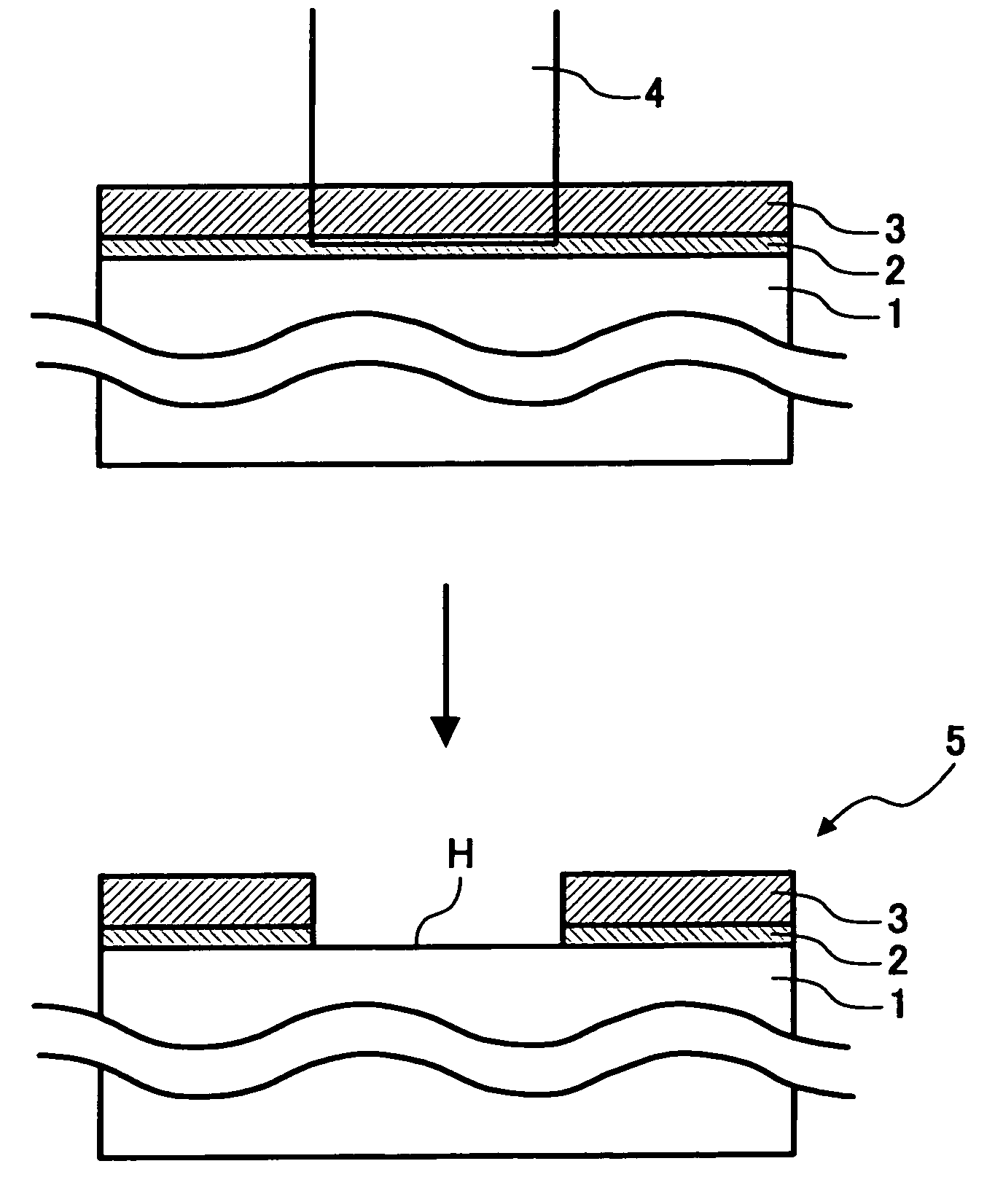Method and apparatus for processing three-dimensional structure, method for producing three-dimensional shape product and three-dimensional structure
a three-dimensional structure and apparatus technology, applied in the direction of manufacturing tools, optical beam sources, instruments, etc., can solve the problems of difficult to uniformly apply resists to substrates, difficulties and drawbacks of the above-mentioned conventional laser process methods, and the lik
- Summary
- Abstract
- Description
- Claims
- Application Information
AI Technical Summary
Benefits of technology
Problems solved by technology
Method used
Image
Examples
first embodiment
[0072]FIG. 1 is a sectional view of a first embodiment in a method for producing a three-dimensional structure according to the invention.
[0073]As shown in FIG. 1, the three-dimensional structure 5 comprises a flat substrate 1 having a flat and smooth surface of glass, Si, SUS or the like; a thin layer for absorption of laser light 2 deposited onto the flat substrate 1; and a transparent layer 3 capable of transmitting a process laser light 4 towards the thin layer for absorption of laser light 2. In the case of a SUS substrate being used for the flat substrate 1, Al, Cu, Ni or the like may be used as a material for the thin layer for absorption of laser light.
[0074]The three-dimensional structure 5 is provided with a removed material section having a very small size where part of the transparent layer 3 and part of the thin layer for absorption of laser light 2 are removed by the absorption of the process laser light 4 incident from the transparent layer 3 in the thin layer for abs...
example 1
[0087]Referring to FIG. 1, example 1 of the laser processing method in the invention will be described.
[0088]As shown in FIG. 1, a thin layer for absorption of laser light 2 made of Ni or the like is deposited onto a flat substrate 1 made of glass, Si or the like, in this example, a glass substrate having a flat upper surface. A transparent layer 3 made of a light transmitting material, such as acrylic resin, ITO (Indium Tin Oxide) or the like is deposited onto the upper surface of the layer 2. A process laser light 4 having certain intensity is spatial-selectively irradiated onto the material to be processed thus laminated from the upper side of the transparent layer 3.
[0089]The certain intensity of the process laser light 4 implies the intensity where almost all of the energy of the laser light is absorbed in the thin layer for absorption of laser light 2. That is, an injection pulse energy E0 of the process laser light 4 absorbed in the thin layer for absorption of laser light 2 ...
second embodiment
[0092]FIG. 2 is a sectional view of a second embodiment in a method for producing a three-dimensional structure according to the invention.
[0093]As shown in FIG. 2, a three-dimensional structure 5 comprises a flat substrate 1 made of glass, Si, SUS or the like and having a flat surface; a thermal isolation layer 6 deposited on the flat substrate 1; a thin layer for absorption of laser light 2 deposited on the thermal isolation layer 6; and a transparent layer 3 for transmitting a process laser light 4 towards the thin layer for absorption of laser light 2.
[0094]Moreover, the three-dimensional structure 5 in the second embodiment is equipped with a finely removed material section formed by removing part of the transparent layer 3 and part of the thin layer for absorption of laser light 2 due to the absorption of the process laser light 4 incident from the side of the transparent layer 3 in the thin layer for absorption of laser light 2; and an interface on the downstream side of the ...
PUM
| Property | Measurement | Unit |
|---|---|---|
| wavelength | aaaaa | aaaaa |
| thickness | aaaaa | aaaaa |
| thickness | aaaaa | aaaaa |
Abstract
Description
Claims
Application Information
 Login to View More
Login to View More - R&D
- Intellectual Property
- Life Sciences
- Materials
- Tech Scout
- Unparalleled Data Quality
- Higher Quality Content
- 60% Fewer Hallucinations
Browse by: Latest US Patents, China's latest patents, Technical Efficacy Thesaurus, Application Domain, Technology Topic, Popular Technical Reports.
© 2025 PatSnap. All rights reserved.Legal|Privacy policy|Modern Slavery Act Transparency Statement|Sitemap|About US| Contact US: help@patsnap.com



